This week we had to bring in all of our work to date so that we could run it past Alice. The idea being that she is able to see if we are keeping up with the work, making notes of everything in the seminars, doing the practicals and challenges she sets us and how our year long project is getting on.
Watching one of my classmates leaving from the room I entered and set my stuff down on the table next to Alice. She brought up her list on the laptop screen of a checklist for things that I needed to have included in my sketchbook and responses.
An investigation into my two sketchbooks, one for the Year Long Project, and another for Experimentation and Dialogues helped Alice to understand what I’d been up to so far this semester and get an idea of where I was struggling or progressing well.
The exercises that we were to have completed are all featured in the sketchbooks and also on this online reflective journal/blog. In some cases the blog posts contain more information and further reflection than I can often fit onto the page with my rubbish handwriting.
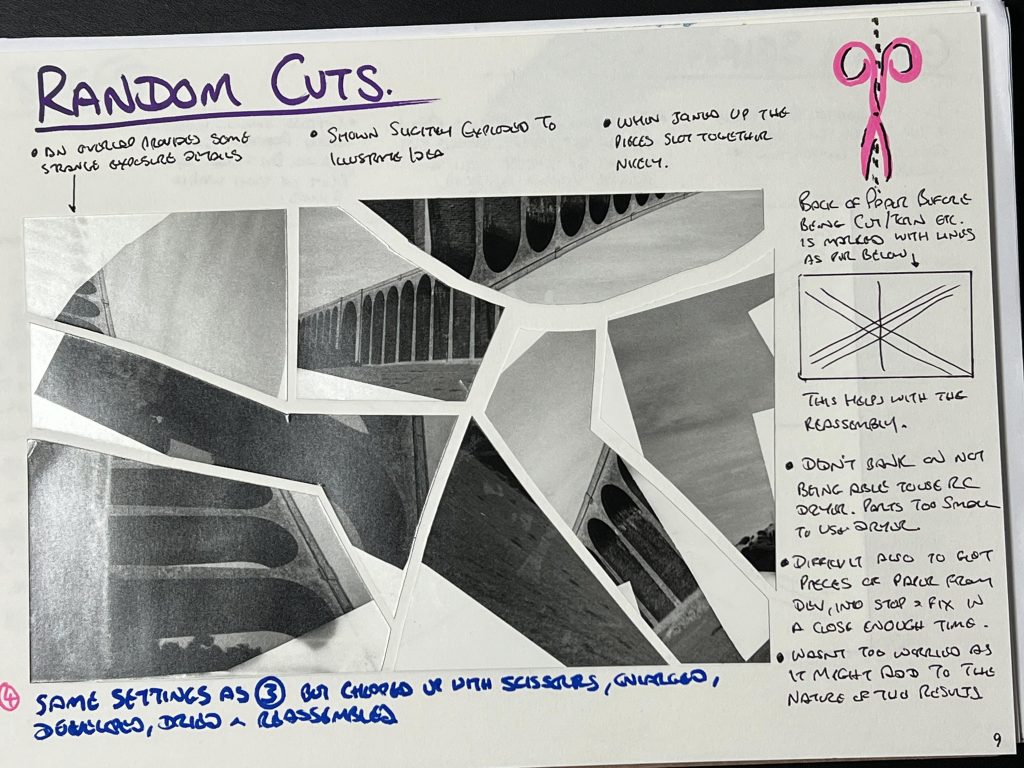
In a few cases, I’ve included some independent research, for example, Chris Killip, Liam Wong, Masataka Nakano, Maurice Broomfield and Jason Chen. I’ve also looked into works by Banksy, Helen Levitt, Vivian Maier, Matt Stuart, Martin Parr, Elliott Erwitt, Saul Leiter and Robert Frank but I’ve not really documented anything about these photographers.
Alice told me that I was doing ok and meeting almost all of the requirements but I could do with doing a little more Independent Research, she suggested that I looked at other photographers or artists working with image distortion, destruction and the like, rather than focussing on the “Weaving” that I’ve been experimenting with recently. It’s a great point, and I don’t want to get stuck in a rabbit hole of weaving alone.
Alice suggested I have a look at a book by William Ewing called Face: The New Photographic Portrait as there is a section in there about masks. This links in with the weaving of the images of my face so I will take a look. The books Dewey number is 779.2 EWI in the library so I checked it out and found a copy on eBay for £3.73 so I’ve ordered that and will have a look over the Christmas break.
Whilst we’re on books, Ieva, one of my classmates, mentioned that she uses mybib.com to generate her in text citations and references in the Harvard style as it’s easier. I’ve just tried it out for the book Alice mentioned and it returned the following.
Ewing, W.A. and Herschdorfer, N. (2006). Face : the new photographic portrait. New York: Thames & Hudson.
Good enough for me this, I will definitely use this in the future and double check it with citethemrightonline.com to ensure they’re correct.
Body Of Work YTD
I proudly displayed the images that I’ve created up to this point with some standard dark room printing in there, along with some weaving of images on laser copier paper and another on 10×12 Fuji Colour Gloss Paper. This latter image was picked up by Alice and she said that it was crying out to be mounted in a frame. I took this as a wonderful complement and thanked her for the kind words.

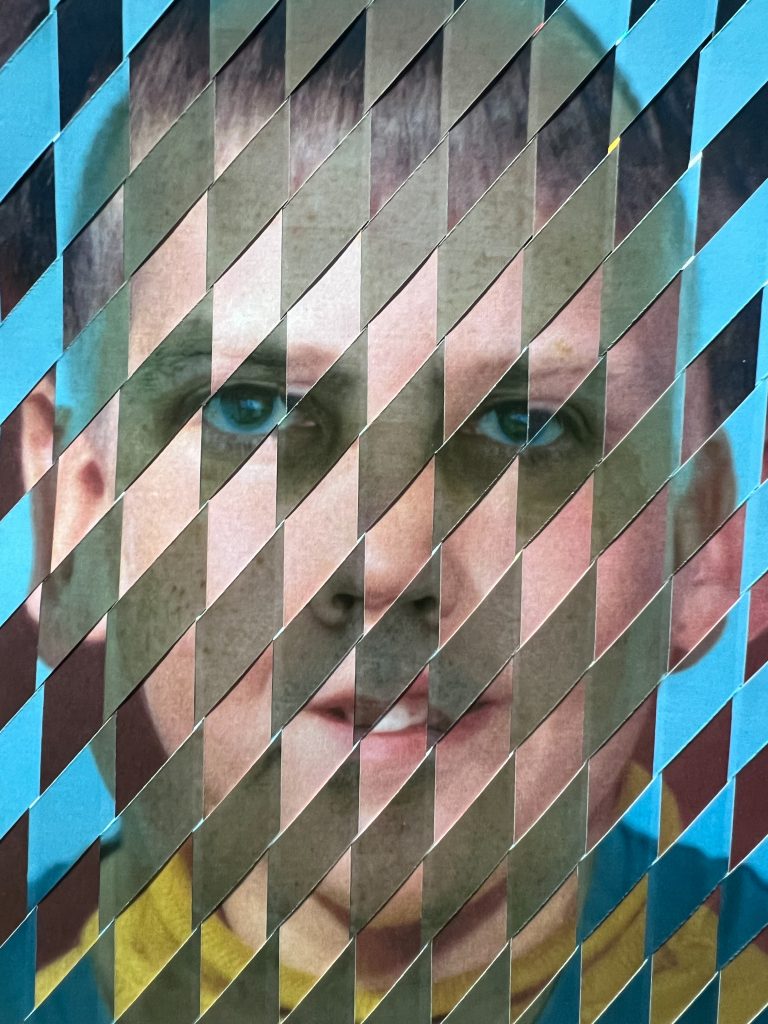
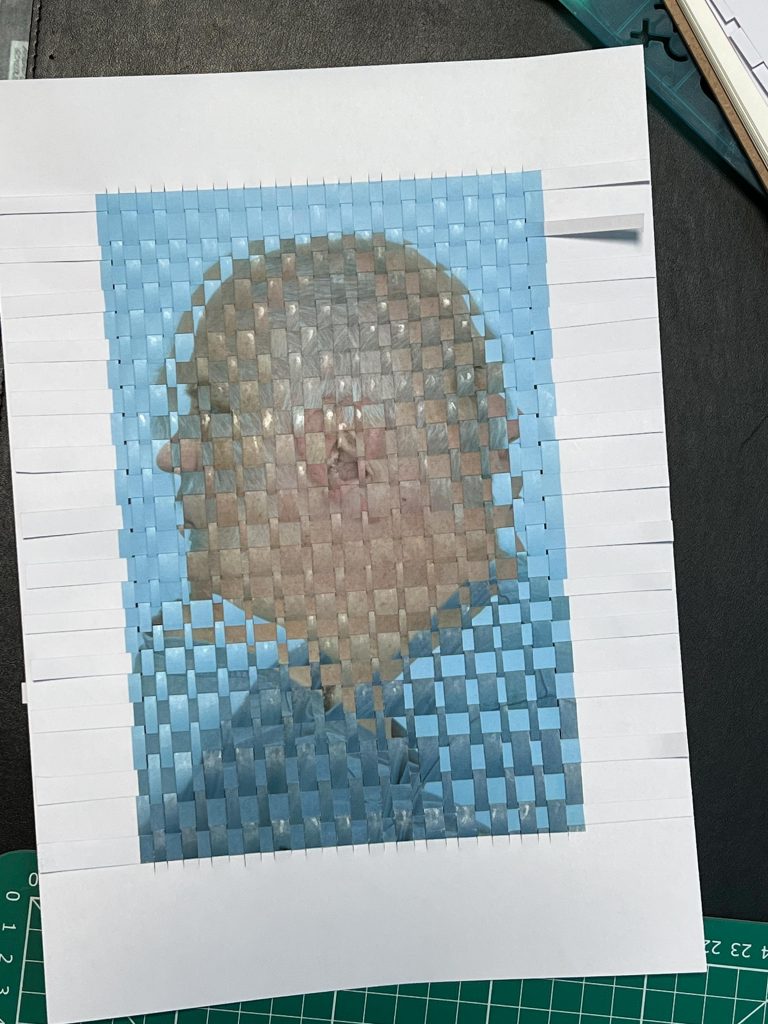



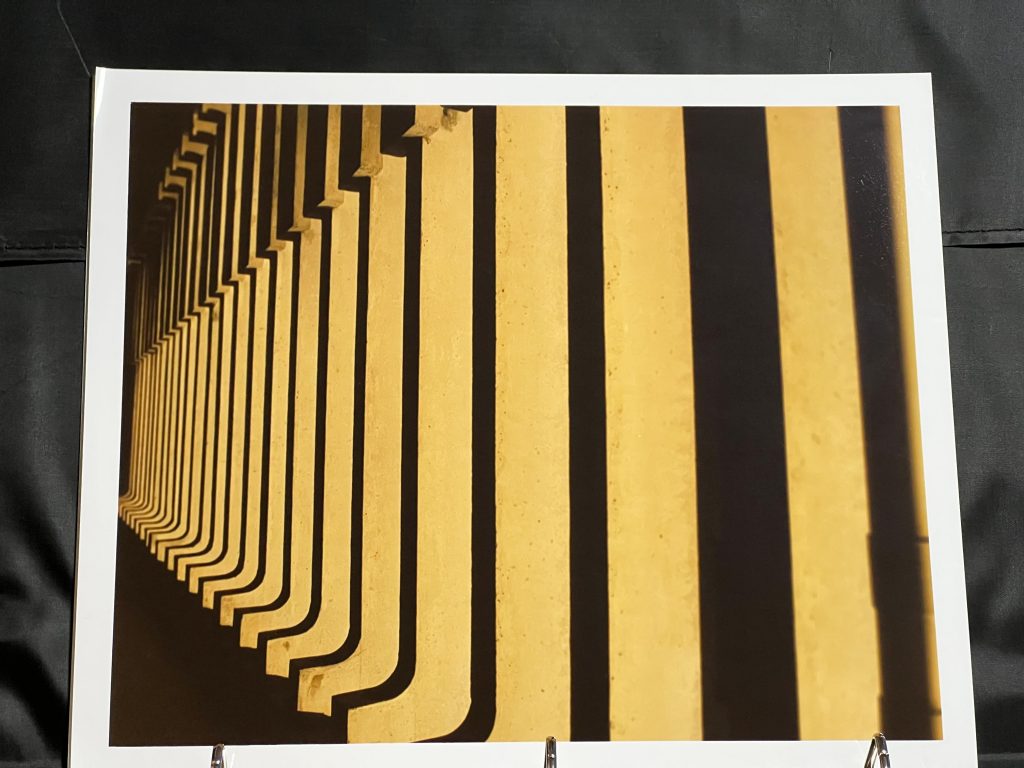
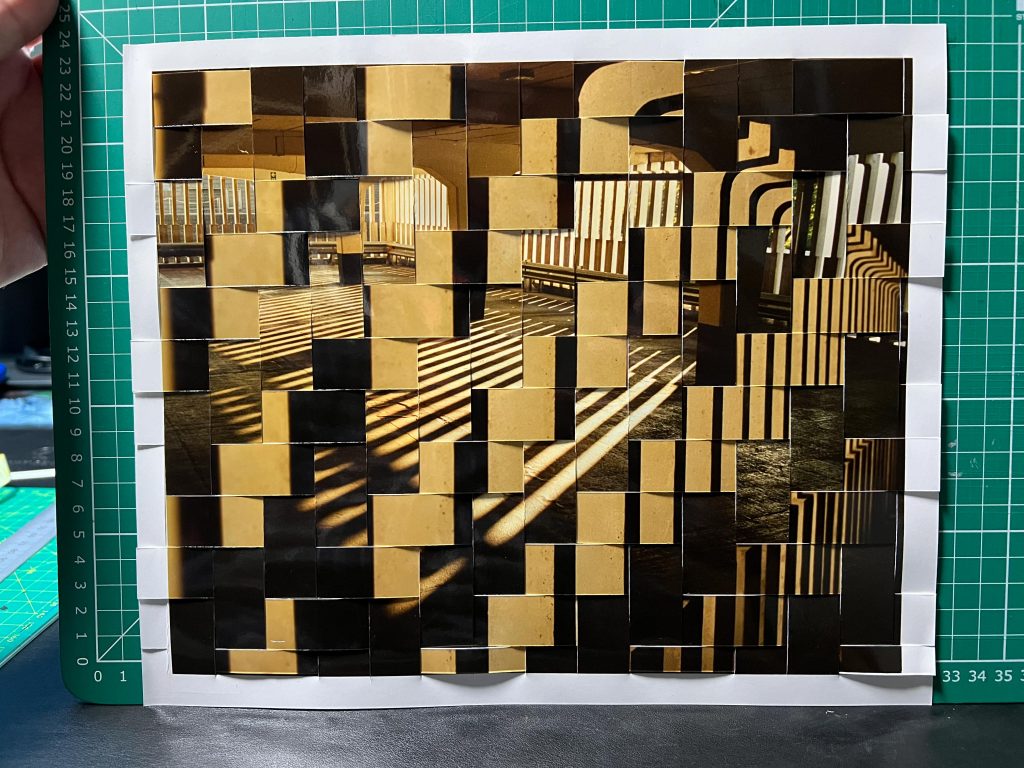
Complementary Digression
Over the last 49 years of my life if I’ve done something good which someone pays me some complement on, I’ve always brushed it off and been super self-deprecating, almost to the point of apologising for my actions. Last year I watched a video by Ted Forbes with his YouTube channel The Art Of Photography titled Never Apologize for a Photo in which Forbes quotes another photographer telling him to never say sorry for a photograph. It’s a very good point as you skew the viewers opinion by apologising for something that they likely didn’t notice or it wasn’t important to anyone else but you.
Since I watched this inspirational video I’ve never apologised for one of my photos and if someone has said something nice I’ve said “thank you, that’s very kind” or something similar. I figure that if someone says that they like some of my work and then I apologise for it, it’s like I’m telling them that they have bad taste and they like rubbish work. It leaves a bad taste in my mouth that I apologised and it might make the person who went out of their way feel awkward and like they may not bother next time.
I’ve fought hard to take complements in a better fashion and I think it does help with my confidence too.
Why Am I Doing This?
The images I shared with Alice I am mostly happy with but as I explained to her, I really don’t know what I’m feeling, what it means or why I’m continuing down the route that I am travelling down in terms of my year long project.
Overlaying PCB tracks onto images was fun but I don’t know if it has any meaning for me, other than going back to my youth on the BTEC ONC In Electronics and Electrical Engineering at Shrewsbury College when we had to make prototype pcbs using UV light and acid etching.
I have played with chopping up the paper and mixing it up before exposing it under the enlarger and then rejoining it together again, but I don’t know why I was doing this. I’ve chosen photographs to do this to, some showing architectural structures and maybe I’m breaking them down to represent my interest in finding out how things are put together and work.
I also got hold of some microfiche aperture cards to see if I could project these onto some old negatives that I fished out of the rubbish twenty years ago. Maybe this is a throwback to my younger years also, do I miss those days? Do I miss getting involved in engineering? Do I liek the history of the company I work for? This might be a possibility, as I collected an archive of images scanned from employees, friends and family when the American parent company considered selling up the company in the early 2000s.
It then went into the weaving phase where I have mixed images of portraits together, along with a night and daytime scene in Tokyo and recently the 10×12 images of concrete and shadows in the Multi Storey car park in my home town. Again history might be why I’m doing this. My images of the car park in Shrewsbury are an attempt to capture the building and area ahead of the changes that are due to come in the near future. The riverside area is proposed to be renovated and remodelled to make better use of the River for tourism and shopping. Many people dislike the “Ugly” building and this makes me like it even more. Before starting the degree course I had a vague understanding of Brutalist architecture style and how concrete was/is used. A few of the buildings in Shrewsbury that are made of concrete and steel tend to be regarded as eyesores, there is the Market Hall which replaced the original Victorian structure, the Lloyds Bank building which replaced an old Black & White timber framed building, Shirehall Council Offices, this car park and then more. I like each of these structures vor their simplicity and engineering being visible from the outside.

Maybe the “Ugly” buildings are being deconstructed and reconstructed in my work on these images? Is that what I’m doing with my portrait, is it ugly to some people but when dissected and rebuilt we have an understanding of what the person’s face is made up of? The photos of Tokyo from Wong and Nakano, why did I choose these two, one night and one day. Do I intend to attempt understanding of the inner workings of the city by taking two different aspects of it and working them together to come up with a more complete picture?
When I asked Alice why I might be doing this type of work, she simply said that it would work itself out of me and I’d come to understand why I was doing what I’m doing. I hope so, I came into the degree course to learn about photography and this chopping up paper is confusing me, not in an un-enjoyable way but one that intrigues me..
Whilst were discussing portraits and my destruction of them Alice mentioned another of the lecturers at the University Of Wolverhampton, Marc Austin. She told me that Marc is a lecturer in Graphic Design and does electronic work on photographs similar to what might be called digital glitching. He is coming in to our course to talk to my peers on the ther module about typefaces so I might collar him on that visit.
Alice mentioned that I appear to have done. a lot of work in the darkrooms so I could even start playing with photoshop to see if I can create some interesting work digitally to accompany the analogue work I’ve already produced. I do remember talking to someone last year about how you an open up a jpg image in an audio file editor, chop a little section out of the “audio wave” and then resave it. The output of the jpg file can still be opened but there has been some corruption created which can give some very interesting effects. This effect is called DataBending and a website is available here for some information on how this can be achieved.
It’s something that I can get on with too, whilst the dark rooms are shut over the Christmas Holidays, watch this space for some experiments and research in the future.
Not for this post, but maybe another, I stayed behind in the colour darkroom after my review to get on with printing a couple of photos out that I wanted on paper and maybe a subject of another weave.. That info will be in a shortly forthcoming post too.
Conclusion
Overall I was pleased with my review, the one callout to find some more independent research sounds like a common theme with my classmates so I’m not overly concerned about it. My exhibition review was submitted at the start of the week so we’ll now await a result of the work and the review we had.
In the meantime, I’ll get on with the research and documenting it and playing in photoshop.
Comments are closed.